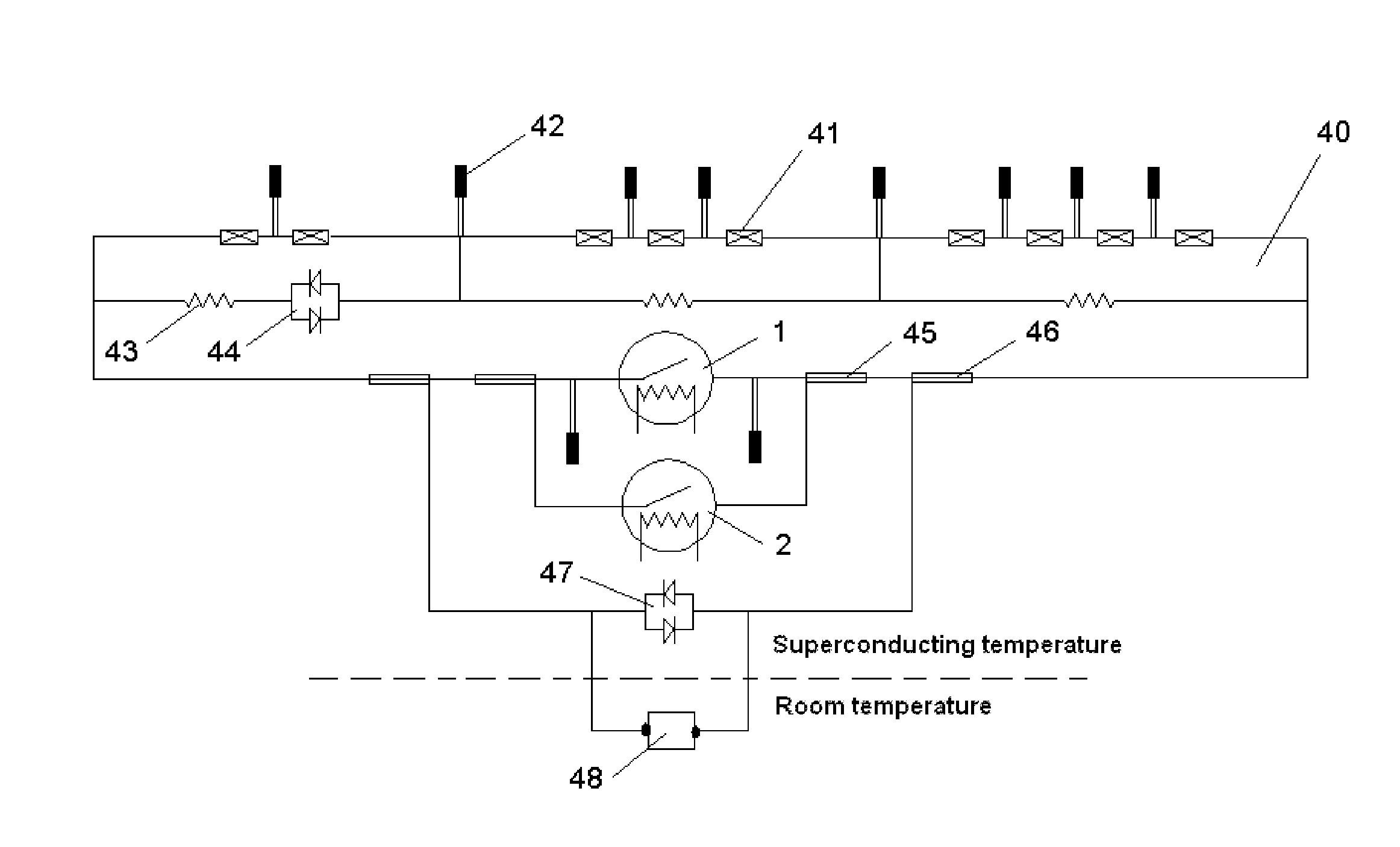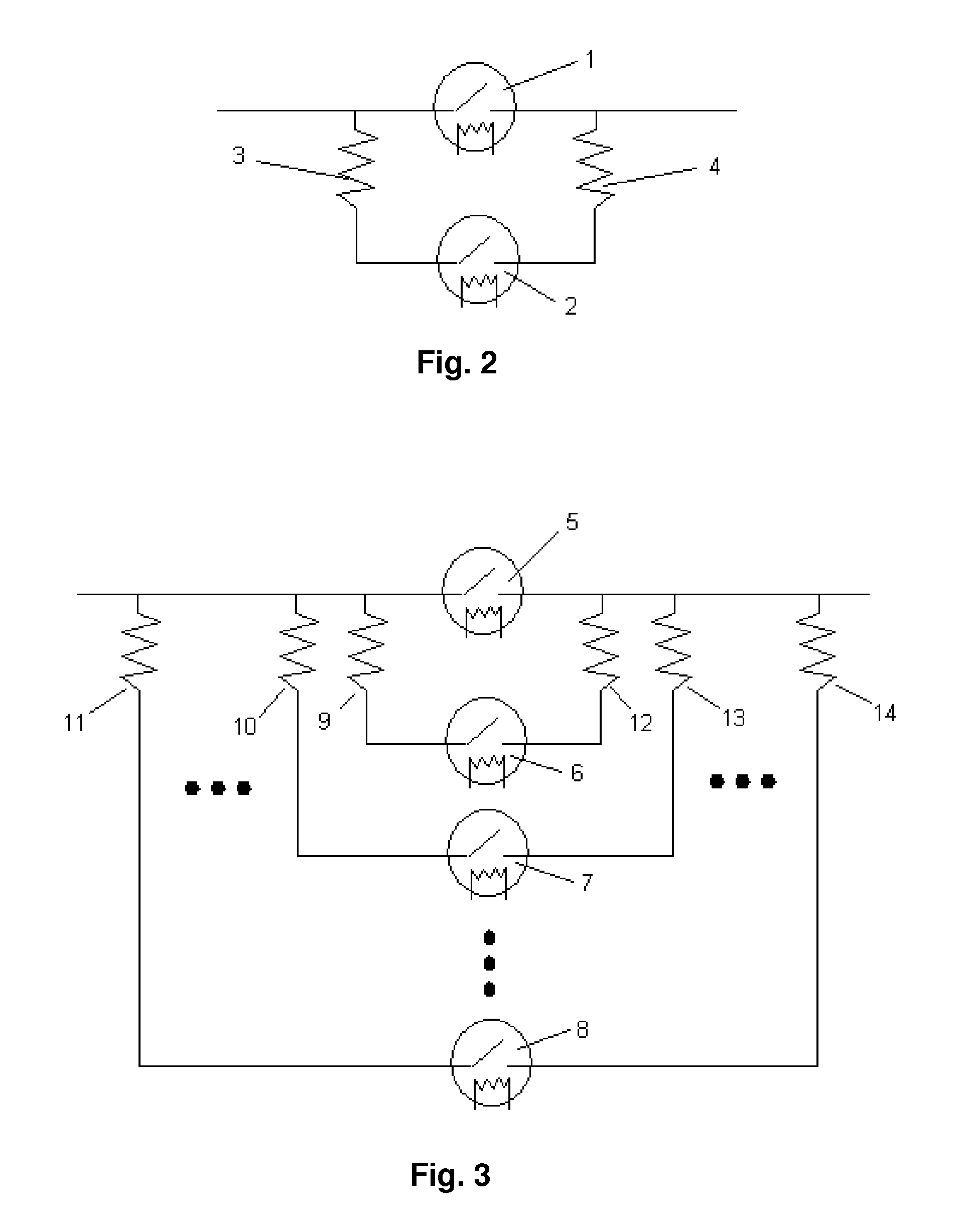Superconducting switch operation
a superconducting switch and superconducting magnet technology, applied in superconducting magnets/coils, magnetic bodies, relays, etc., can solve problems such as quenching of the magnetic field, and achieve the effect of low resistance associated with the auxiliary superconducting switch, low voltage drop across and low power dissipation in the main superconducting switch
- Summary
- Abstract
- Description
- Claims
- Application Information
AI Technical Summary
Benefits of technology
Problems solved by technology
Method used
Image
Examples
second embodiment
[0025]If the magnet operating current is high, it is not possible for a single auxiliary superconducting switch to handle the operating current when the main superconducting switch is opened, due to the high current rate of change from the main superconducting switch to the auxiliary superconducting switch. In this event then more than one auxiliary superconducting switch is required. FIG. 3 shows superconducting switch system in which two or more auxiliary superconducting switches 6, 7, 8 are connected to the magnet circuit in parallel with the main superconducting switch 5, which carries the magnet operating current during normal operation of the magnet circuit, by resistive solder joints 9, 10, 11, 12, 13, 14. If the main superconducting switch 5 quenches (or opens), the current will transfer to the auxiliary superconducting switches 6, 7, 8 through the solder joints 9, 10, 11, 12, 13, 14. Subsequently, after the main superconducting switch 5 has recovered, the voltage across the...
third embodiment
[0026]To reduce the current transfer rate from the main superconducting switch to the auxiliary superconducting switch, an inductor may be added to the magnet circuit. FIG. 4 shows a third embodiment in which an inductor 16 is serially connected between the main superconducting switch 15 and the auxiliary superconducting switch 17. The inductor 16 serves to reduce the current transfer rate from the main superconducting switch 15 to the auxiliary superconducting switch 17, which is resistively connected to the circuit through the connecting parts 18 and 19 generally constituted by solder joints. If the main superconducting switch 15 quenches, the current will transfer to the auxiliary superconducting switch 17 through the connecting parts 18 and 19. Subsequently, after the main superconducting switch 15 and the inductor 16 have recovered, the voltage across the connecting parts 18 and 19 will drive the current back to the main superconducting switch 15. The presence of the inductor 1...
seventh embodiment
[0030]In a seventh embodiment as shown in FIG. 8, a multi-strand superconducting switch 33 is provided in place of both the main superconducting switch and the auxiliary superconducting switch. One portion of the strands of the switch 33 is connected by a superconducting joint to the magnet circuit to serve as the main superconducting switch, and the other portion of the strands of the switch 33 is resistively connected to the magnet circuit through connecting parts 34 and 35 to serve as the auxiliary superconducting switch so that, if the main superconducting switch quenches, the current will transfer to the auxiliary superconducting switch through the connecting parts 34 and 35. Subsequently, after the portion of the strands constituting the main superconducting switch has recovered, the voltage across the connecting parts 34 and 35 will drive the operating current back to the portion of the strands constituting the main superconducting switch. A preconditioning procedure is carri...
PUM
 Login to View More
Login to View More Abstract
Description
Claims
Application Information
 Login to View More
Login to View More - R&D
- Intellectual Property
- Life Sciences
- Materials
- Tech Scout
- Unparalleled Data Quality
- Higher Quality Content
- 60% Fewer Hallucinations
Browse by: Latest US Patents, China's latest patents, Technical Efficacy Thesaurus, Application Domain, Technology Topic, Popular Technical Reports.
© 2025 PatSnap. All rights reserved.Legal|Privacy policy|Modern Slavery Act Transparency Statement|Sitemap|About US| Contact US: help@patsnap.com



